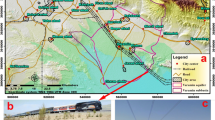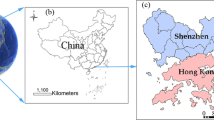Abstract
Shallow landslide represents one of the most devastating morphodynamic processes that bring about great destructions to human life and infrastructure. Landslide spatial prediction can significantly help government agencies in land use and mitigation measure planning. Nevertheless, landslide spatial modeling remains a very challenging problem due to its inherent complexity. This study proposes an integration of geographical information system (GIS) and gene expression programming (GEP) for predicting rainfall-induced shallow landslide occurrences in Son La Province, Vietnam. A landslide inventory map has been constructed based on historical landslide locations. Furthermore, a dataset which features 12 influencing factors is collected using GIS technology. Based on the GEP algorithm and the collected dataset, an empirical model for spatial prediction of the shallow landslide has been established by means of natural selection. The predictive capability of the model has been verified by the area under the curve calculation. Experimental results point out that the newly proposed approach is a promising tool for shallow landslide prediction.








Similar content being viewed by others
References
Ahlheim M, Fror O, Heinke A, Keil A, Duc NM, Dinh PV, Saint-Macary C, Zeller M (2009) Landslides in mountainous regions of northern Vietnam: causes, protection strategies and the assessment of economic losses. Int J Ecol Econ Stat 15(F09):108–130
Alkroosh I, Nikraz H (2011) Correlation of pile axial capacity and CPT data using gene expression programming. Geotech Geol Eng 29(5):725–748
Althuwaynee OF, Pradhan B, Lee S (2012) Application of an evidential belief function model in landslide susceptibility mapping. Comput Geosci 44:120–135
Beale MH, Hagan MT, Demuth HB (2012) Neural network toolbox user’s guide. The MathWorks, Inc
Borrelli L, Cofone G, Coscarelli R, Gullà G (2014) Shallow landslides triggered by consecutive rainfall events at Catanzaro strait (Calabria–Southern Italy). J Maps 11(5):730–744
Browne NPA, dos Santos MV (2010) Adaptive representations for improving evolvability, parameter control, and parallelization of gene expression programming. Appl Comput Intell Soft Comput 2010:19
Chang K-T, Chiang S-H, Chen Y-C, Mondini AC (2014) Modeling the spatial occurrence of shallow landslides triggered by typhoons. Geomorphology 208:137–148
Chauhan S, Sharma M, Arora MK, Gupta NK (2010) Landslide susceptibility zonation through ratings derived from artificial neural network. Int J Appl Earth Obs 12(5):340–350
Chen S-C, Chang C-C, Chan H-C, Huang L-M, Lin L-L (2013) Modeling typhoon event-induced landslides using GIS-based logistic regression: a case study of Alishan forestry railway, Taiwan. Math Probl Eng 2013:9
Dai FC, Lee CF, Li J, Xu ZW (2001) Assessment of landslide susceptibility on the natural terrain of Lantau Island, Hong Kong. Environ Geol 40(3):381–391
Dan NT, Tuan TA, Thu TH, Hong PV, Hung LQ, Luong NV, Hai NT, Nhung H, Ha NTV, Thu DH, Thanh LV, Hien D, Mai D (2011) Application of remote sensing, GIS, and GPS for the study of landslides at the Son La hydropower basin and proposed remedial measures. In: Technical Report, Institute of Marine Geology & Geophysics, Vietnam Academy of Science and Technology, Hanoi
Dou J, Tien Bui D, Yunus A, Jia K, Song X, Revhaug I, Xia H, Zhu Z (2015) Optimization of causative factors for landslide susceptibility evaluation using remote sensing and GIS data in parts of Niigata, Japan. PLoS ONE 10(7):0133262
Ebtehaj I, Bonakdari H, Zaji AH, Azimi H, Sharifi A (2015) Gene expression programming to predict the discharge coefficient in rectangular side weirs. Appl Soft Comput 35:618–628
Emamgolizadeh S, Bateni SM, Shahsavani D, Ashrafi T, Ghorbani H (2015) Estimation of soil cation exchange capacity using genetic expression programming (GEP) and multivariate adaptive regression splines (MARS). J Hydrol 529:1590–1600 (in press)
Ercanoglu M (2005) Landslide susceptibility assessment of SE Bartin (West Black Sea region, Turkey) by artificial neural networks. Nat Hazards Earth Syst Sci 5(6):979–992
Ferreira C (2001) Gene expression programming a new adaptive algorithm for solving problems. Complex Syst 13(2):87–129
Ferreira C (2006) Gene expression programming mathematical modeling by an artificial intelligence. Springer, Berlin, Heidelberg
Ferreira C (2013) Getting started with classification. GeneXproTools, http://www.gepsoft.com/
Gandomi AH, Alavi AH, Kazemi S, Gandomi M (2014) Formulation of shear strength of slender RC beams using gene expression programming, part I: without shear reinforcement. Autom Constr 42:112–121
Goetz JN, Brenning A, Petschko H, Leopold P (2015) Evaluating machine learning and statistical prediction techniques for landslide susceptibility modeling. Comput Geosci 81:1–11
Gomez H, Kavzoglu T (2005) Assessment of shallow landslide susceptibility using artificial neural networks in Jabonosa River Basin, Venezuela. Eng Geol 78(1–2):11–27
Hoang N-D, Pham A-D (2016) Hybrid artificial intelligence approach based on metaheuristic and machine learning for slope stability assessment: a multinational data analysis. Expert Syst Appl 46(15):60–68
Hoang N-D, Tien Bui D (2018) GIS-based landslide spatial modeling using batch-training back-propagation artificial neural network: a study of model parameters. In: Tien Bui D, Ngoc Do A, Bui H-B, Hoang N-D (eds) Advances and applications in geospatial technology and earth resources: proceedings of the international conference on geo-spatial technologies and earth resources 2017, Springer, Cham, pp 239–254
Hoang N-D, Tien-Bui D (2016) A novel relevance vector machine classifier with cuckoo search optimization for spatial prediction of landslides. J Comput Civ Eng 30(5):04016001
Hoang N-D, Chen C-T, Liao K-W (2017) Prediction of chloride diffusion in cement mortar using multi-gene genetic programming and multivariate adaptive regression splines. Measurement 112(Supplement C):141–149
Hong H, Pradhan B, Xu C, Tien Bui D (2015) Spatial prediction of landslide hazard at the Yihuang area (China) using two-class kernel logistic regression, alternating decision tree and support vector machines. CATENA 133:266–281
Iovine GR, Greco R, Gariano S, Pellegrino A, Terranova O (2014) Shallow-landslide susceptibility in the Costa Viola mountain ridge (southern Calabria, Italy) with considerations on the role of causal factors. Nat Hazards 73(1):111–136
Jolliffe IT (2010) Principal component analysis, 2nd edn. Springer, New York
Kavzoglu T, Sahin E, Colkesen I (2014) Landslide susceptibility mapping using GIS-based multi-criteria decision analysis, support vector machines, and logistic regression. Landslides 11(3):425–439
Kayadelen C (2011) Soil liquefaction modeling by genetic expression programming and neuro-fuzzy. Expert Syst Appl 38(4):4080–4087
Khan M, Azamathulla HM, Tufail M, Ab Ghani A (2012) Bridge pier scour prediction by gene expression programming. Water Manag 165(WM9):481–493
Lima P, Steger S, Glade T, Tilch N, Schwarz L, Kociu A (2017) Landslide susceptibility mapping at national scale: a first attempt for Austria. Springer, New York, pp 943–951
Magliulo P, Di Lisio A, Russo F, Zelano A (2008) Geomorphology and landslide susceptibility assessment using GIS and bivariate statistics: a case study in southern Italy. Nat Hazards 47(3):411–435
MathWorks (2012) Statistics Toolbox. The MathWorks, Inc
Micheletti N, Foresti L, Robert S, Leuenberger M, Pedrazzini A, Jaboyedoff M, Kanevski M (2014) Machine learning feature selection methods for landslide susceptibility mapping. Math Geosci 46(1):33–57
Mondini AC, Marchesini I, Rossi M, Chang K-T, Pasquariello G, Guzzetti F (2013) Bayesian framework for mapping and classifying shallow landslides exploiting remote sensing and topographic data. Geomorphology 201:135–147
Mousavi SM, Aminian P, Gandomi AH, Alavi AH, Bolandi H (2012) A new predictive model for compressive strength of HPC using gene expression programming. Adv Eng Softw 45(1):105–114
Nazari A, Pacheco Torgal F (2013) Modeling the compressive strength of geopolymeric binders by gene expression programming-GEP. Expert Syst Appl 40(14):5427–5438
Nefeslioglu HA, Gokceoglu C, Sonmez H (2008) An assessment on the use of logistic regression and artificial neural networks with different sampling strategies for the preparation of landslide susceptibility maps. Eng Geol 97(3–4):171–191
Nguyen KL (2010). Assessing landslide vulnerability in Vietnam: conceptual framework and proposed research techniques. In: Proceedings of the awareness of the need for environmental protection—a role for higher education, 2010, Ho Chi Minh City, Vietnam, pp 131–139
Nguyen Q-K, Tien Bui D, Hoang N-D, Trinh P, Nguyen V-H, Yilmaz I (2017) A novel hybrid approach based on instance based learning classifier and rotation forest ensemble for spatial prediction of rainfall-induced shallow landslides using GIS. Sustainability 9(5):813
Park HJ, Lee JH, Woo I (2013) Assessment of rainfall-induced shallow landslide susceptibility using a GIS-based probabilistic approach. Eng Geol 161:1–15
Pradhan B, Sezer EA, Gokceoglu C, Buchroithner MF (2010) Landslide susceptibility mapping by neuro-fuzzy approach in a landslide-prone area (Cameron Highlands, Malaysia). IEEE Trans Geosci Remote Sens 48(12):4164–4177
Schmaltz EM, Steger S, Glade T (2017) The influence of forest cover on landslide occurrence explored with spatio-temporal information. Geomorphology 290:250–264
Sezer EA, Pradhan B, Gokceoglu C (2011) Manifestation of an adaptive neuro-fuzzy model on landslide susceptibility mapping: Klang valley, Malaysia. Expert Syst Appl 38(7):8208–8219
Shahabi H, Hashim M (2015) Landslide susceptibility mapping using GIS-based statistical models and remote sensing data in tropical environment. Sci Rep 5:9899
Shirzadi A, Bui DT, Pham BT, Solaimani K, Chapi K, Kavian A, Shahabi H, Revhaug I (2017) Shallow landslide susceptibility assessment using a novel hybrid intelligence approach. Environ Earth Sci 76(2):60
Song Y, Gong J, Gao S, Wang D, Cui T, Li Y, Wei B (2012) Susceptibility assessment of earthquake-induced landslides using Bayesian network: a case study in Beichuan, China. Comput Geosci 42:189–199
Tien Bui D, Pradhan B, Lofman O, Revhaug I (2012) Landslide susceptibility assessment in vietnam using support vector machines, decision tree, and Naive Bayes models. Math Probl Eng 2012:26
Tien Bui D, Pradhan B, Revhaug I, Nguyen DB, Pham HV, Bui QN (2013) A novel hybrid evidential belief function-based fuzzy logic model in spatial prediction of rainfall-induced shallow landslides in the Lang Son city area (Vietnam). Geomat Nat Hazards Risk 6(3):243–271
Tien Bui D, Tuan TA, Klempe H, Pradhan B, Revhaug I (2016) Spatial prediction models for shallow landslide hazards: a comparative assessment of the efficacy of support vector machines, artificial neural networks, kernel logistic regression, and logistic model tree. Landslides 13(2):361–378. https://doi.org/10.1007/s10346-015-0557-6
Tsangaratos P, Benardos A (2014) Estimating landslide susceptibility through a artificial neural network classifier. Nat. Hazards 74(3):1489–1516
Tuan TA, Dan NT (2012) Landslide susceptibility mapping and zoning in the Son La hydropower catchment area using the analytical hierarchy process. J Sci Earth (Vietnamese) 3:223–232
Vahidnia MH, Alesheikh AA, Alimohammadi A, Hosseinali F (2010) A GIS-based neuro-fuzzy procedure for integrating knowledge and data in landslide susceptibility mapping. Comput Geosci 36(9):1101–1114
Wu Z, Fan H, Liu G (2015) Forecasting construction and demolition waste using gene expression programming. J Comput Civ Eng 29(5):04014059
Yalcin A (2008) GIS-based landslide susceptibility mapping using analytical hierarchy process and bivariate statistics in Ardesen (Turkey): comparisons of results and confirmations. CATENA 72(1):1–12
Yao X, Tham LG, Dai FC (2008) Landslide susceptibility mapping based on support vector machine: a case study on natural slopes of Hong Kong, China. Geomorphology 101(4):572–582
Yem (2006) Assessment of landslides, flash floods, and debris flows in selected prone areas in the northern mountainous Vietnam and recommendation of remedial measures to prevent and mitigate potential damages. In: National project report, Vietnam
Author information
Authors and Affiliations
Corresponding author
Rights and permissions
About this article
Cite this article
Hoang, ND., Tien Bui, D. Spatial prediction of rainfall-induced shallow landslides using gene expression programming integrated with GIS: a case study in Vietnam. Nat Hazards 92, 1871–1887 (2018). https://doi.org/10.1007/s11069-018-3286-z
Received:
Accepted:
Published:
Issue Date:
DOI: https://doi.org/10.1007/s11069-018-3286-z




